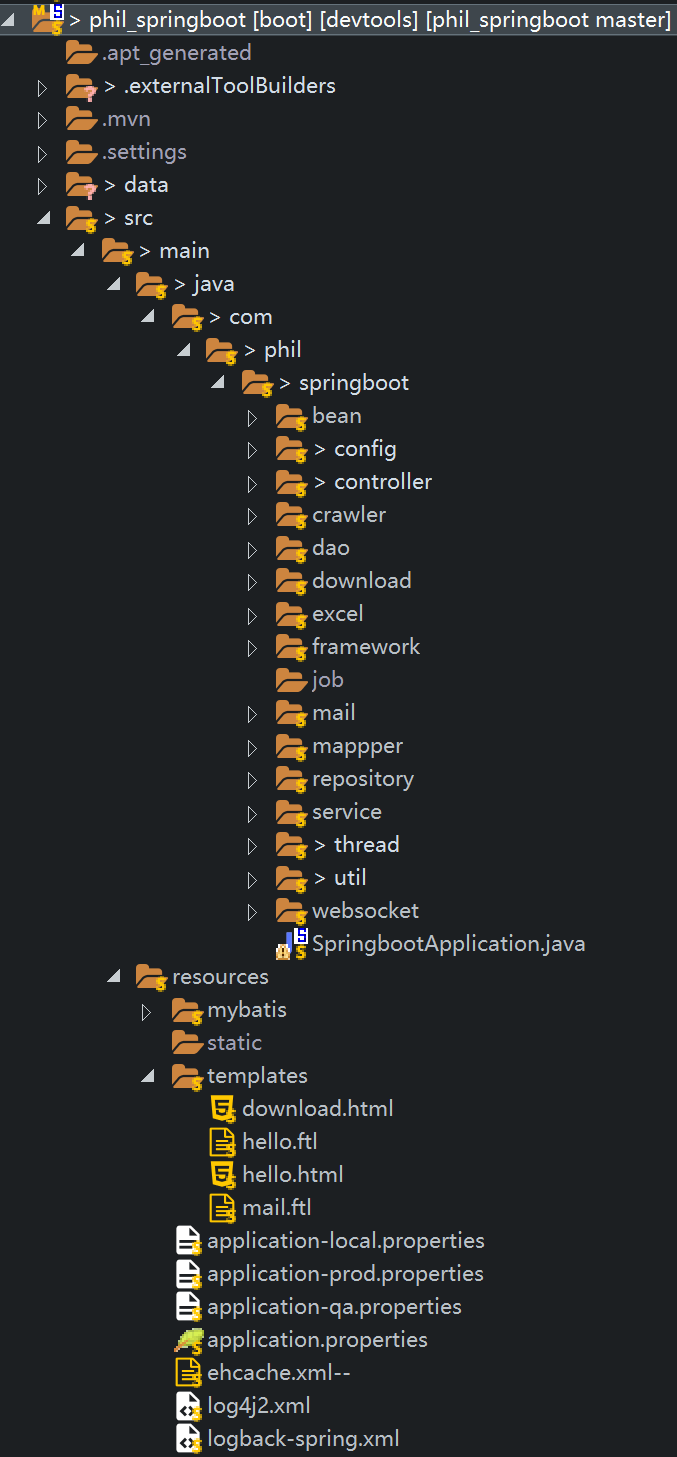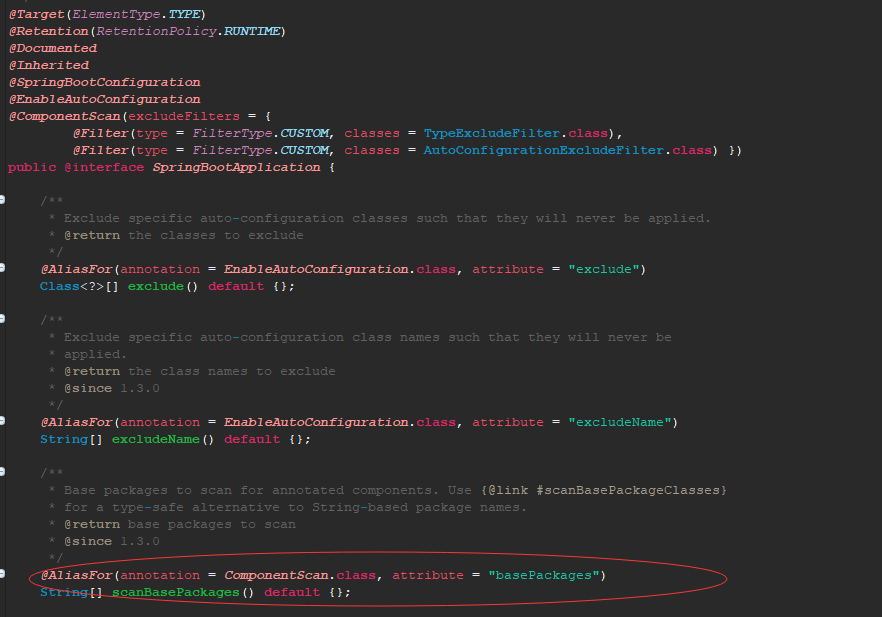Spring Boot 學習之基礎篇(一)
Spring Boot 是由 Pivotal 團隊提供的全新框架,其設計目的是用來簡化新 Spring 應用的初始搭建以及開發過程。該框架使用了特定的方式來進行配置,從而使開發人員不再需要定義樣板化的配置。
一、環境搭建
建立一個Maven專案,結構如圖,檔案目錄可忽略。如何建立Maven專案
1、新增依賴
在 pom.xml 檔案中新增如下依賴
<!-- 定義公共資源版本 --> <parent> <groupId>org.springframework.boot</groupId> <artifactId>spring-boot-starter-parent</artifactId> <version>2.0.1.RELEASE</version> <relativePath /> </parent> <properties> <project.build.sourceEncoding>UTF-8</project.build.sourceEncoding> <project.reporting.outputEncoding>UTF-8</project.reporting.outputEncoding> <java.version>1.8</java.version> </properties> <dependencies> <!-- 上邊引入 parent,因此 下邊無需指定版本 --> <!-- 包含 mvc,aop 等jar資源 --> <dependency> <groupId>org.springframework.boot</groupId> <artifactId>spring-boot-starter-web</artifactId> </dependency> </dependencies> <build> <plugins> <plugin> <groupId>org.springframework.boot</groupId> <artifactId>spring-boot-maven-plugin</artifactId> </plugin> </plugins> </build>
2、建立目錄和配置檔案
在resources 原始檔目錄,建立 application.properties 檔案、static 和 templates 的資料夾。
application.properties:用於配置專案執行所需的配置資料。
static:用於存放靜態資源,如:css、js、圖片等。
templates:用於存放模板檔案。
3、建立啟動類
在src根目錄下建立,一定要在根目錄,看原始碼預設掃描此類所在包下的所有註解。
/** 該註解指定專案為springboot,由此類當作程式入口,自動裝配 web 依賴的環境 **/ @SpringBootApplication public class SpringbootApplication { public static void main(String[] args) { SpringApplication.run(SpringbootApplication.class, args); } }
4、啟動專案
在 SpringbootApplication 檔案中右鍵 Run as -> Java Application。圖就不上了
二、熱部署
pom.xml修改並新增
<dependency>
<groupId>org.springframework.boot</groupId>
<artifactId>spring-boot-devtools</artifactId>
<scope>runtime</scope>
</dependency><build> <plugins> <plugin> <groupId>org.springframework.boot</groupId> <artifactId>spring-boot-maven-plugin</artifactId> <configuration> <!-- 沒有該配置,devtools 不生效 --> <fork>true</fork> </configuration> </plugin> </plugins> </build>
ctrl+s儲存後,再啟動專案,隨便建立/修改一個檔案並儲存,會發現控制檯列印 springboot 重新載入檔案的資訊。
三、多環境
如初圖,按照我在SGM的開發規則,application.properties 是 springboot 在執行中所需要的配置資訊。
當我們在開發階段,本地機器開發,測試的時候用測試伺服器測試,上線時使用正式環境的伺服器。
這三種環境需要的配置資訊都不一樣,當切換環境執行專案時,需要手動的修改多出配置資訊,非常容易出錯。
為了解決上述問題,springboot 提供多環境配置的機制,讓開發者非常容易的根據需求而切換不同的配置環境。
在 src/main/resources 目錄下建立三個配置檔案:
application-local.properties:用於本地環境
application-qa.properties:用於測試環境
application-prod.properties:用於生產環境
可以在這個三個配置檔案中設定不同的資訊,application.properties 配置公共的資訊。
在 application.properties 中配置:
spring.profiles.active=local表示啟用application-local.properties檔案配置,springboot 會載入使用 application.properties 和 application-local.properties 配置檔案的資訊。
在application-local.properties配置加上
server.port = 8081再重新啟動專案發現只能用8081埠訪問了(如果被佔用會報錯的,再修改)
四、配置日誌
1、配置日誌檔案
spring boot 預設會載入 classpath:logback-spring.xml 或者 classpath:logback-spring.groovy。
如需要自定義檔名稱,在 application.properties 中配置 logging.config 選項即可。
在 src/main/resources 下建立 logback-spring.xml 檔案,內容如下:
<?xml version="1.0" encoding="UTF-8"?>
<configuration>
<!-- 檔案輸出格式 -->
<property name="PATTERN" value="%-12(%d{yyyy-MM-dd HH:mm:ss.SSS}) |-%-5level [%thread] %c [%L] -| %msg%n" />
<!-- local檔案路徑 -->
<property name="LOCAL_FILE_PATH" value="E:/Eclipse/workspace/sgm/phil-springboot/log" />
<!-- pro檔案路徑 -->
<property name="PRO_FILE_PATH" value="/midware/logfiles" />
<!-- 本地環境 -->
<springProfile name="local">
<!-- 每天產生一個檔案 -->
<appender name="LOCAL_FILE_PATH" class="ch.qos.logback.core.rolling.RollingFileAppender">
<!-- 檔案路徑 -->
<file>${LOCAL_FILE_PATH}</file>
<rollingPolicy class="ch.qos.logback.core.rolling.TimeBasedRollingPolicy">
<!-- 檔名稱 -->
<fileNamePattern>${LOCAL_FILE_PATH}/info.%d{yyyy-MM-dd}.log</fileNamePattern>
<!-- 檔案最大儲存歷史數量 -->
<MaxHistory>100</MaxHistory>
</rollingPolicy>
<layout class="ch.qos.logback.classic.PatternLayout">
<pattern>${PATTERN}</pattern>
</layout>
</appender>
<root level="info">
<appender-ref ref="LOCAL_FILE_PATH" />
</root>
</springProfile>
<!-- 測試環境 -->
<springProfile name="qa">
<appender name="CONSOLE" class="ch.qos.logback.core.ConsoleAppender">
<encoder>
<pattern>${PATTERN}</pattern>
</encoder>
</appender>
<logger name="com.phil.springboot" level="debug"/>
<root level="info">
<appender-ref ref="CONSOLE" />
</root>
</springProfile>
<!-- 生產環境 -->
<springProfile name="prod">
<appender name="PROD_FILE" class="ch.qos.logback.core.rolling.RollingFileAppender">
<file>${PRO_FILE_PATH}</file>
<rollingPolicy class="ch.qos.logback.core.rolling.TimeBasedRollingPolicy">
<fileNamePattern>${PRO_FILE_PATH}/warn.%d{yyyy-MM-dd}.log</fileNamePattern>
<MaxHistory>100</MaxHistory>
</rollingPolicy>
<layout class="ch.qos.logback.classic.PatternLayout">
<pattern>${PATTERN}</pattern>
</layout>
</appender>
<root level="warn">
<appender-ref ref="PROD_FILE" />
</root>
</springProfile>其中,springProfile 標籤的 name 屬性對應 application.properties 中的 spring.profiles.active 的配置。
即 spring.profiles.active 的值可以看作是日誌配置檔案中對應的 springProfile 是否生效的開關。
2、配置 log4j2
新增並修改依賴
<!-- log4j2 -->
<dependency>
<groupId>org.springframework.boot</groupId>
<artifactId>spring-boot-starter-log4j2</artifactId>
</dependency>
<dependency>
<groupId>org.springframework.boot</groupId>
<artifactId>spring-boot-starter</artifactId>
<exclusions>
<exclusion>
<groupId>org.springframework.boot</groupId>
<artifactId>spring-boot-starter-logging</artifactId>
</exclusion>
</exclusions>
</dependency>配置日誌檔案
pring boot 預設會載入 classpath:log4j2.xml 或者 classpath:log4j2-spring.xml。
如需要自定義檔名稱,在 application.properties 中配置 logging.config 選項即可。
log4j2.xml 檔案內容如下:
<?xml version="1.0" encoding="utf-8"?>
<configuration>
<properties>
<!-- 檔案輸出格式 -->
<property name="PATTERN">%d{yyyy-MM-dd HH:mm:ss.SSS} |-%-5level [%thread] %c [%L] -| %msg%n</property>
</properties>
<appenders>
<Console name="CONSOLE" target="system_out">
<PatternLayout pattern="${PATTERN}" />
</Console>
</appenders>
<loggers>
<logger name="com.phil.springboot" level="debug"/>
<root level="info"><!-- 預設是debug -->
<appenderref ref="CONSOLE" />
</root>
</loggers>
</configuration>除了在日誌配置檔案中設定引數之外,還可以在 application-*.properties 中設定,日誌相關的配置:
logging.config # 日誌配置檔案路徑,如 classpath:logback-spring.xml
logging.exception-conversion-word # 記錄異常時使用的轉換詞
logging.file # 記錄日誌的檔名稱,如:test.log
logging.level.* # 日誌對映,如:logging.level.root=WARN,logging.level.org.springframework.web=DEBUG
logging.path # 記錄日誌的檔案路徑,如:d:/
logging.pattern.console # 向控制檯輸出的日誌格式,只支援預設的 logback 設定。
logging.pattern.file # 向記錄日誌檔案輸出的日誌格式,只支援預設的 logback 設定。
logging.pattern.level # 用於呈現日誌級別的格式,只支援預設的 logback 設定。
logging.register-shutdown-hook # 初始化時為日誌系統註冊一個關閉鉤子五、常用註解
@Configuration # 作用於類上,相當於一個 xml 配置檔案
@Bean # 作用於方法上,相當於 xml 配置中的 <bean>
@SpringBootApplication # Spring Boot的核心註解,是一個組合註解,用於啟動類上
@EnableAutoConfiguration # 啟用自動配置,允許載入第三方 Jar 包的配置
@ComponentScan # 預設掃描 @SpringBootApplication 所在類的同級目錄以及它的子目錄
@PropertySource # 載入 properties 檔案
@Value # 將配置檔案的屬性注入到 Bean 中特定的成員變數
@EnableConfigurationProperties # 開啟一個特性,讓配置檔案的屬性可以注入到 Bean 中,與 @ConfigurationProperties 結合使用
@ConfigurationProperties # 關聯配置檔案中的屬性到 Bean 中
@Import # 載入指定 Class 檔案,其生命週期被 Spring 管理
@ImportResource # 載入 xml 檔案六、讀取配置檔案
1、屬性裝配
有兩種方式:使用 @Value 註解和 Environment 物件。
在application-local.properties 中新增如下自定義配置
userName=root
password=root建立配置類如下
package com.phil.springboot.config;
import org.springframework.beans.factory.annotation.Autowired;
import org.springframework.beans.factory.annotation.Value;
import org.springframework.context.annotation.Configuration;
import org.springframework.core.env.Environment;
@Configuration
public class EnvironmentValueConfig {
@Value("${userName}")
private String userName;
@Autowired
private Environment environment;
public void show() {
System.out.println("userName:" + this.userName);
System.out.println("password:" + this.environment.getProperty("password"));
}
}通過 @Value 獲取 userName 配置;通過 environment 獲取 password 配置。
修改SpringbootApplication啟動類的main方法
ConfigurableApplicationContext context = SpringApplication.run(SpringbootApplication.class, args);
context.getBean(EnvironmentValueConfig.class).show();2、物件裝配
修改下配置
phil.userName=root
phil.password=root建立需要裝配的物件
package com.phil.springboot.config;
import org.springframework.boot.context.properties.ConfigurationProperties;
import org.springframework.stereotype.Component;
@Component
@ConfigurationProperties(prefix = "phil")
public class EnvironmentValueProperties {
private String userName;
private String password;
public String getUserName() {
return userName;
}
public void setUserName(String userName) {
this.userName = userName;
}
public String getPassword() {
return password;
}
public void setPassword(String password) {
this.password = password;
}
public void show() {
System.out.println("phil.userName=" + this.userName);
System.out.println("phil.password=" + this.password);
}
}如果此處出現Warnning,在pom.xml加上如下
dependency>
<groupId>org.springframework.boot</groupId>
<artifactId>spring-boot-configuration-processor</artifactId>
<optional>true</optional>
</dependency>重新啟動


